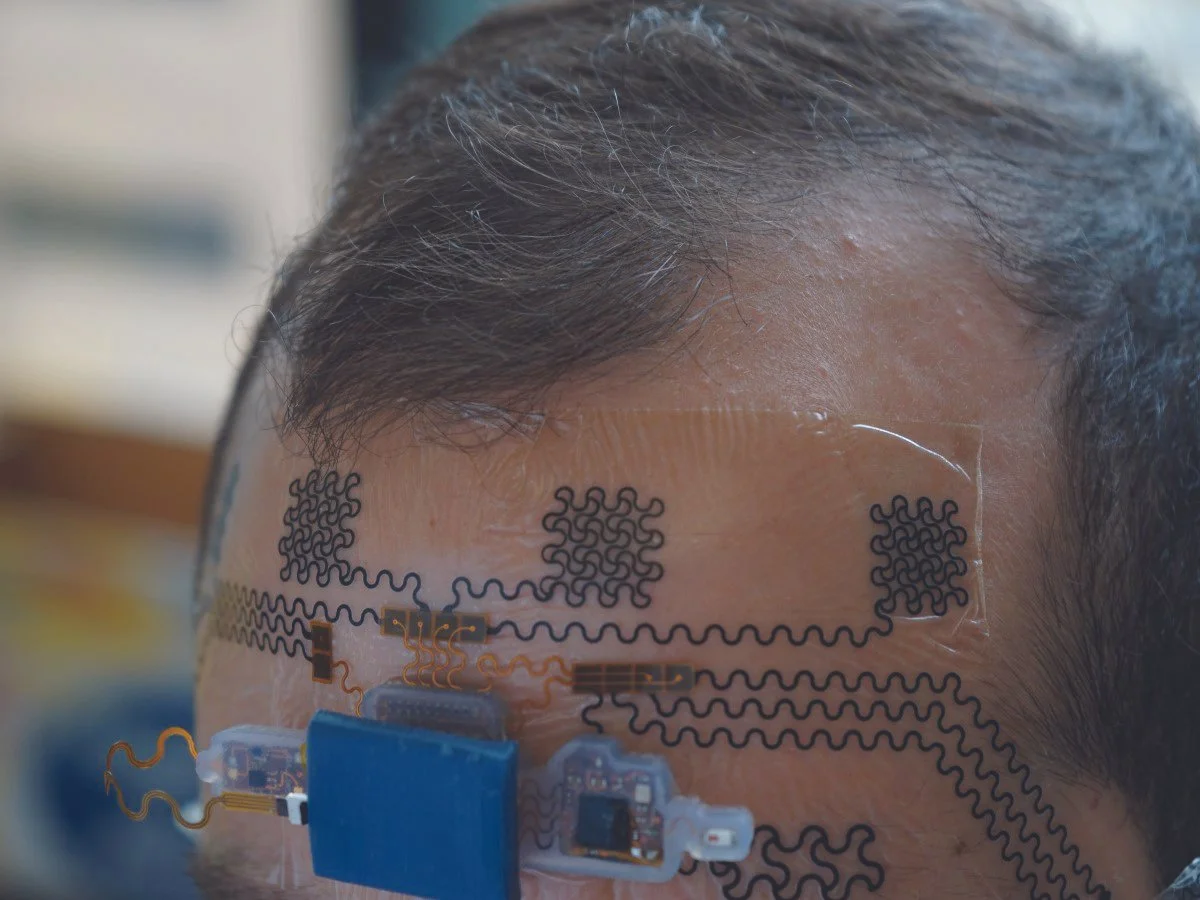Electronic Tattoo
The wearable device measures stress and anxiety. Photo courtesy of Nanshu Lu/ University of Texas Austin
Wearable devices to measure heart or respiratory rates have been around awhile. But Nanshu Lu, a professor and Carol Cockrell Curran Chair in Engineering at the University of Texas at Austin, and members of her lab have taken the technology several steps further. They’ve recently introduced a wireless sensor-driven tattoo worn on the forehead to measure levels of stress and anxiety by decoding brainwaves.
The device is particularly useful for monitoring those who work in high-stress, high-stakes jobs like air traffic controllers or surgeons, Lu says.
The low-cost, disposable tattoo is far from permanent. The paper-thin sensors that comprise the “tattoo” are part of a stretchable, wearable device that fits over the forehead and can be taken off much like a Band-Aid.
It continuously measures electroencephalography (EEG) brainwaves to give an objective measure of the wearer’s mental workload. In other words, people won’t have to rely on their own subjective feelings of burnout before shifting focus. The e-tattoo would gauge their levels of stress and alert them: take a break or risk a break down. “Especially today, with the explosion in technology, there’s more information and decisions we have to make than our brain’s processing power can handle,” Lu says. “In so many occupations today, people become mentally overloaded — especially in jobs like firefighter or first responder — the kinds of highly dynamic and highly demanding roles that, if you’re not at your best performance, it puts others in danger.”
Humans perform best when they find balance in a cognitive zone, neither overwhelmed nor bored. Current mental workload assessment relies on the NASA Task Load Index, a lengthy and subjective survey participants complete after performing tasks, Lu says.
The index is a subjective measure of cognitive load and it happens after the work is completed, Lu says. On the job, it’s hard for those who generally work under pressure- and tension-filled conditions to know exactly when it’s time to step away.
That’s where the lab’s e-tattoo would come in, she adds.
Brain and Eye Waves
There are devices today — mostly in the form of wearable caps — that can measure whole-head, EEG waves to report back on a number of health conditions. But they come with some important drawbacks. Sensor patches placed over hair have a hard time getting accurate readings. Also, due to differences in head sizes, the caps don’t fit accurately on everyone, which can lead to problems with measurement, Lu adds.
For that reason, her team focused solely on the forehead when developing their e-tattoo.
“That meant we had only a limited region to measure brainwaves; but fortunately for us, the prefrontal lobe is closest to the forehead and is mostly responsible for decision making and reasoning and calculations connected with those,” Lu says.
Unlike EEG caps that are bulky with dangling wires, the wireless e-tattoo consists of a lightweight battery pack and thin wavy sensors that stretch and conform to a wearer’s skin for comfort and for clear signals.
To ensure a perfect fit (which the whole-head caps can’t provide), Lu’s team measures the wearer’s facial features and then manufactures personalized tattoos, which ensures sensors are always correctly located and receiving the right signals, she says.
The researchers’ forehead tattoo also measures electrooculography (EOG) signals from the eyes given off during eye movements like blinking or eyeball rotation. Because EOG signals are 100 times stronger than those of EEGs, they have the potential to contaminate brainwaves, so researchers remove them from the EEG for a clearer signal that doesn’t reflect eye activities.
Yet, EOGs do have the potential to tell the researchers some aspects of mental workload.
The tattoo collects four EEG and two EOG channels and wirelessly transmits them to a Bluetooth enabled Android phone, which downloads the recorded signals to a machine learning algorithm for interpretation.
“It’s not a very beautiful heartbeat signal,” Lu says, “it looks like a lot of noise.”
The algorithm gets better and better at interpretating signals over time.
Time to Take a Break
The researchers tested their e-tattoo on six people as they completed a memory puzzle that became increasingly more difficult. As their mental workload rose, participants showed higher activity in theta and delta brainwaves, signaling increased cognitive demand, while alpha and beta activity decreased, indicating mental fatigue. The results suggest the device can detect when the brain is struggling, Lu says.
But the device can also predict the point of mental fatigue, cueing the wearer needs to take a break from a high-stress, high-mental-workload task, Lu adds. To do this, the researchers trained a computer model to estimate mental workload based on signals from the e-tattoo and that can, from there, predict the point of mental fatigue.
The researchers’ ultimate goal is to design e-tattoos that will measure signals from the brain, the heart and other parts of the body.
“We want to have an e-tattoo body sensor network that can fully decode the health and status of one’s whole body,” Lu says.

